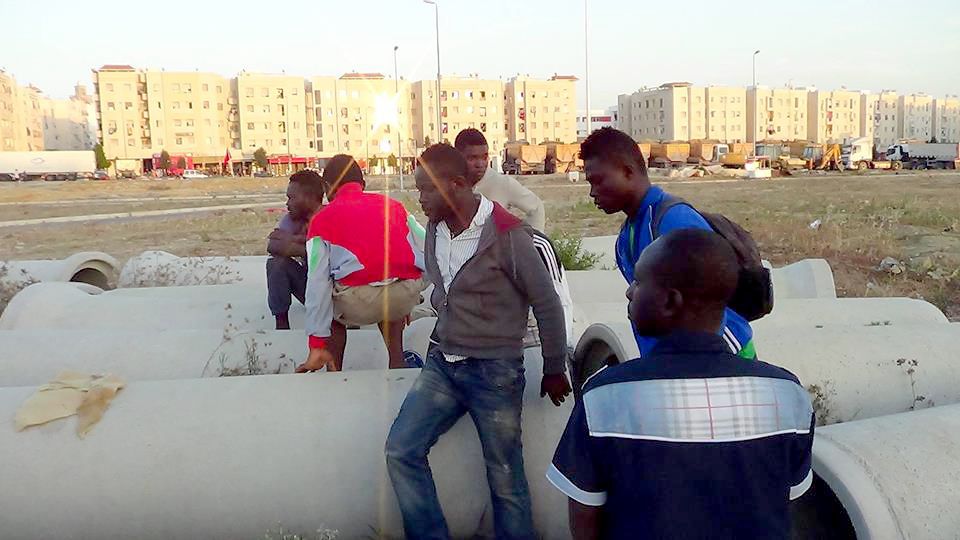
“This is a picture of the forests,” Michael says, flicking through the photos on his laptop. “At night they will struggle. I mean, how can a plastic bag save you from the cold? If it’s cold, it will be cold on you. If it rains, it will rain on you. If the police come there, they will burn down all this.”
Michael, a twenty-something man from Gambia, is showing me photos that he has collected during his year and five months in Morocco: some taken by him, others by journalists that he has met and befriended, others by friends who are migrants like himself. At great personal risk, he has been documenting human rights abuses and the daily struggles that migrants undergo in Morocco. (Some of the photos from his collection are interspersed throughout this story.) The images are unsettling. Young children sleeping in the cold. Men who have been beaten half to death. Families living in squalor in the forests.
When these scenes in the bush were shot, Michael says, 400 to 500 men, women, and children—all fleeing intense poverty, corrupt governments, or state and rebel violence in Sub-Saharan Africa—lived there. This forest, on the far outskirts of Tangier, is one of many staging grounds that people use for their clandestine crossings into Spain. Facing persecution in Morocco, they risk their lives to reach Europe in the hope of finding work, opportunity, and basic rights.
The police regularly evict them from the woods, but they keep coming back. They have no choice, Michael says. “Where you want them to go now?”
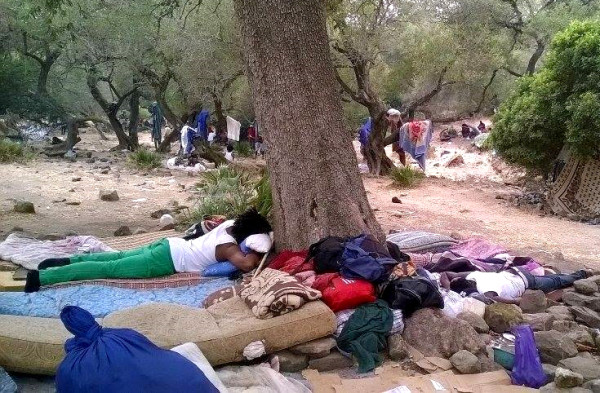
I ’ve come to Morocco to see this situation for myself, and also to meet people from Interzone Voices, a project some friends of mine are setting up to document the human rights abuses that migrants suffer in the northern African country. Of the three main Mediterranean sea crossings, the migration route from Morocco to Spain is the quietest. But though it draws far fewer people than the Turkey–Greece and Libya–Italy crossings do, a large number of them get through each year. In 2015, there were 3,845 arrivals via the western Mediterranean route—and 104 registered deaths.
It would be impossible to count the number of people who arrive in Morocco in search of a better life, but it’s clear that only a small percentage actually make it across the Strait of Gibraltar to Spain. Many migrants spend years scraping by on meager incomes, treated with suspicion and prejudice by the Moroccan population, and regularly harassed and roughed up by the state forces.
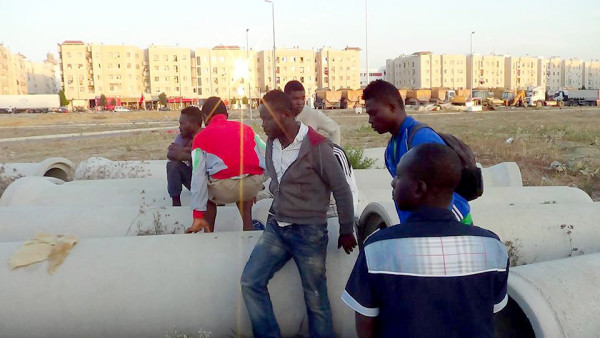
Last year, Moroccan authorities banned a number of performances of a play about the suffering endured by African migrants. In February, a free health clinic for migrants was denied permission to begin operations in Casablanca. People attempting to bring light to this blatant discrimination are often arrested, or abruptly deported and barred from reentering the country. So it was with some degree of risk that my friends began their project.
Before a friend and I made the trip from Spain, I had been hearing stories for years about the situation in Morocco from activists and the few NGOs and grassroots organizations that have succeeded in collecting and disseminating information about the repression there. In the English-speaking media, what is happening in Morocco goes largely unmentioned. In some of the independent Spanish press, though, I read articles about the triple layer of six-meter-high fences that keeps Ceuta and Melilla, two Spanish enclaves in North Africa, out of reach of African migrants desperate to reach European land. I saw pictures of the wounds inflicted by the razor wire, and others of migrants sitting atop those fences, waiting for the Spanish and Moroccan border guards to beat them and toss them back to the other side. I heard from friends working with the migrants that those who try to cross into Melilla live in that forest in the photos, readying themselves for a futile charge at the border: for even one person to touch Spanish soil, hundreds must storm the fences at the same time to overwhelm the guards.
• • •
He shows me a picture from Ceuta, one of two Spanish cities on African soil. In the photo, Spanish officers from the country’s civil guard are dragging a man who has just scaled the three fences back to Moroccan territory—a practice that under international law is an illegal pushback, as it denies the person’s legal right to claim asylum. The guards do not care, Michael says.
“This is how they treat the black people, you see? They are beating you very well. After they are beating you, they will carry you like a bag of ice, throw you to the Moroccan-side people … If they want to kill you, they kill you very seriously.”
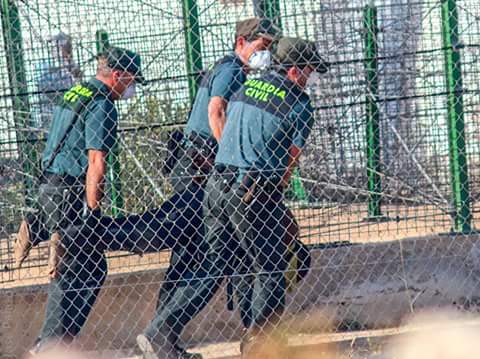
After crossing the Strait of Gibraltar by ferry, my friend and I arrive in Tangier. Raz O’Connor, one of my friends working in Morocco, meets us at the port. Raz is in Morocco to record an album with a band of West African refugees called Diaspora, to help raise money and awareness for Interzone Voices. He leads us through the Medina, the oldest part of the city, pointing out some of the sights to help us get our bearings. Some boys run past us, shouting and wolf-whistling. As we meander past a café in the Petit Socco, a beautiful young West African woman jumps up to greet us. Raz introduces us in his stilted French. I fumble for any French words still left in my brain from my school days, settling eventually on “Bonjour!”
We sip strong black coffee outside the café. Mariama is another member of the project. She’s from Senegal, a former French colony, and English isn’t one of her four languages. We smile warmly at each other. I guess she is a few years younger than I am. Later I learn she has left her young children with her mother in Senegal. One of her two kids is seriously ill with a condition she developed after a complicated birth. Health care is very expensive in Senegal, and I gather that making money to cover her daughter’s medical bills is one of many reasons Mariama came to Morocco.
Mariama insists on arranging my bags neatly by the table, ordering my coffee, and running to the shop when she discovers we want to buy SIM cards. I run after her, laughing. “No, wait, let me do it!”
I learn later that Mariama was taking a risk by drinking coffee with us. These days, Moroccan police hunt migrants in the streets, beat them, and arrest them.
• • •
A photo of a bloodied man appears on the screen of Michael’s laptop. He talks about how the man got caught in a police raid on the apartment where he and a number of other migrants lived. “This was a guy that was … beaten, all his head was broken.”
“Did he die?” I ask. Then I see the picture. My hand flutters to my mouth. “He’s dead. Oh my god, he’s really dead.”
He shows me another photo of a dead man. “This guy was pushed,” he says. “They were searching for them, you know? So when he went up to the terrace, the police went there. They spied him there, they push him back off the terrace. He fell down, he break his head.”
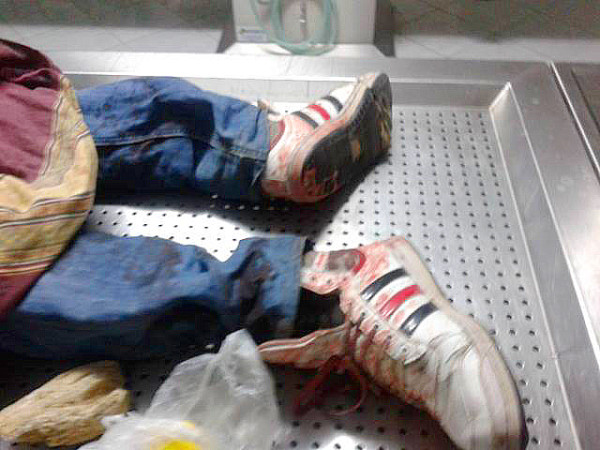
The narrow lanes of the Medina twist around themselves, making me lose track of which way we are going. Mariama takes us past crumbling yellow buildings that seem to be made of dust. Children play by a water fountain in a dirty courtyard. A man in a traditional djellaba robe perches on a stoop in front of a tiny table, selling carefully arranged packs of cigarettes.
We arrive at an apartment my friends have rented for Interzone Voices. In one of the upstairs rooms, a group of people from England, Senegal, Morocco, Gambia, the United States, and Italy have congregated around a low table. Michael, the collector of photos, is among them.
He and the other West Africans talk about how the police in Tangier have recently escalated their street sweeps. “People don’t feel secure to go outside to beg for food, like they used to do,” Michael says. Meanwhile, those who have long made their living selling cheap Chinese-made phones and other wares on the street are now finding that this previously tolerated activity is no longer safe. Money—and therefore food—is becoming scarce.
Things have become so bad that many migrants he knows are working in graveyards, Michael says. They sit by the tombstones until they see someone come to visit a deceased friend or family member. “They will wash the grave, come and clean everything for you. You give them some money. This is how people make money here now.”
In Tangier it is no longer safe to walk around with black skin, day or night. “You cannot stay in the home for the whole weeks, you need to go out,” Michael says. But then the police might arrest you—anywhere, at any time. “You are scared to walk in the street. You are scared to sit in a café, you are scared to sit in a restaurant, because you see what they do to people here.”
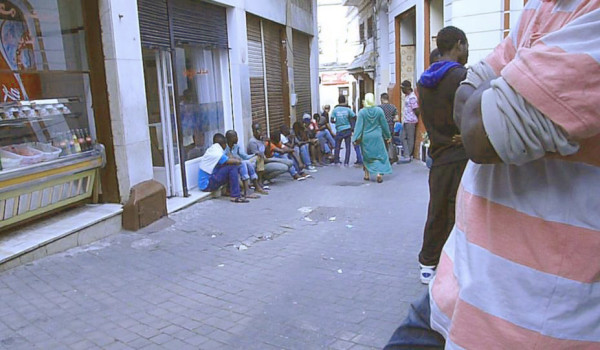
“There are thousands of black people living in Tangier,” adds a slightly older Gambian man, “but you will not see them.” Michael tells me that this man, known to his friends as P, was arrested recently just for being in a Senegalese restaurant frequented by migrants. “You are not even free to go and meet your friends,” Michael says.
I’m not surprised to hear that there’s a Senegalese restaurant in town. There are thousands of Senegalese people living here, so why shouldn’t there be? But later I see the “restaurant”—actually a walled-off section of a Moroccan café—and hear how much the restaurant’s owners had to negotiate to get that tiny space. It’s only then that I realize the truth: of course there isn’t a proper Senegalese restaurant in Tangier. To open a business, you need to have rights.
• • •
“Before, the Senegalese restaurant at dinner, this is how it used to be. All these people hang out in the door and wait for people they know who come to eat. So many people used to stand there like that.”
These days, however, the restaurant is far from crowded: people are afraid to go there because of the frequent police raids. “That’s where they arrested P two days ago,” Michael says. “They went there and arrest everybody, even the ones who are already eating, who just bought their plate.”
The police won’t even bother checking your papers, he adds. During one raid, a friend of Michael’s showed the police his residence permit. They ripped it in half, beat him up, and carted him and the other migrants they arrested to the forest. “They leave them there in the cold, near the sea.… Why? Why are they treating people like this?”
Many of the restaurant’s former patrons, I learn, have been staying in their homes to hide from police, or have decided to leave Morocco—risking the dangerous journey to Libya through Algeria.
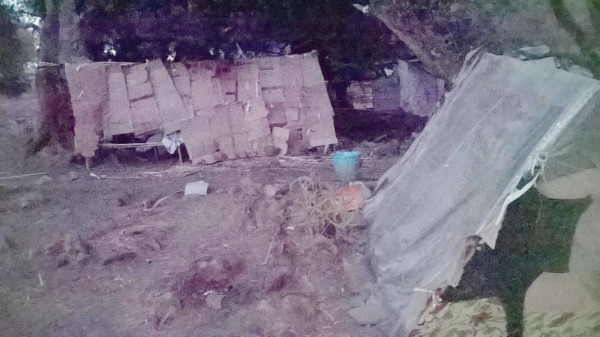
The following day, my friend and I meet Michael in the Grand Socco. Not far from the city square, we walk past a grassy area. Michael tells us that in July fifty people set up camp in this small park after police had evicted every black person they could find—residence permit or not—in Boukhalef, a run-down neighborhood out by the airport where many migrants live. He found two women and six of their children sleeping in the park with all their belongings. Their husbands had been arrested and sent south, an increasingly common practice in Morocco. After taking their money and anything else of value, the police will put migrants on buses and dump them in the middle of the desert close to Tiznit or beyond—as far south as the Mauritanian border more than a thousand kilometers away. The migrants will then have to make their way slowly back to Tangier.
In a cluster of market stalls, Michael points out a storefront. It’s one of the shops where migrants buy zodiacs—the black rubber boats they use to cross the strait, he says. “When the police seize the boats, they sell them back to the man in this shop, and then you have to come again and buy the boat.”
I snap a covert picture of the shop with my phone. In Morocco, journalism can get you deported.
The café owner smiles broadly when he sees Michael, gesturing to a table in the corner. We set up his laptop, tilting the screen away from prying eyes. Michael opens the folder where he keeps the pictures.
• • •
“This is the process in Boukhalef when they were removing people out of their houses. This is how they go, like they’re coming for a war,” Michael says. The photo shows hundreds of militarized police gathering outside an apartment block.
“You know, you live in a house. One day the soldiers will come, remove your stuff, throw them out of the window, take your husband for deportation, and then they will leave you like this on the streets.” If you protest, Michael adds, the soldiers will kick you and pummel you with their batons.
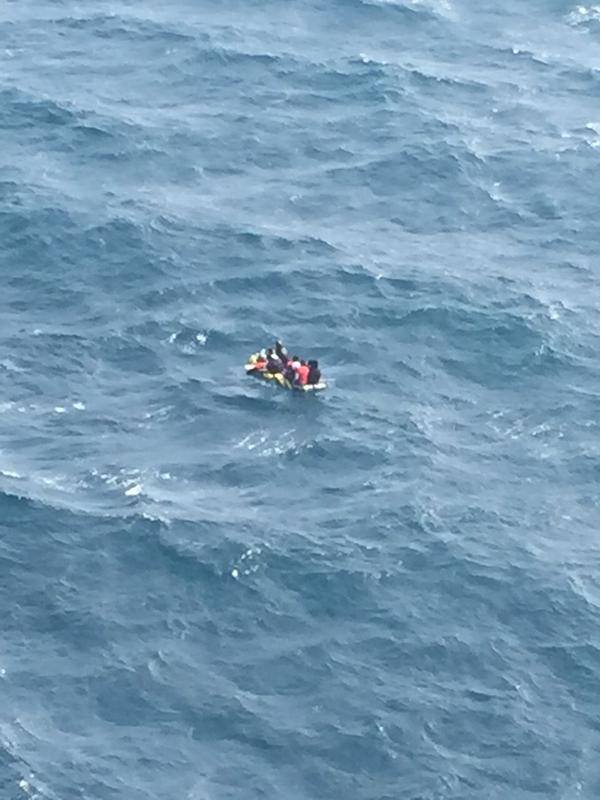
Shortly before I leave for Spain, a small group of people from Interzone Voices are hanging out in the little flat in the Medina. Raz puts on a film for us to watch on his little laptop screen. It’s Selma, the Hollywood film about Martin Luther King’s epic civil-rights march from Selma to Montgomery, Alabama. As I watch its re-enactment of police officers clubbing black men and women back in 1965, a lump rises in my throat. Has nothing changed?
The next day, I head to the Kasbah, the old fort at the top of the Medina. From up there you can look across the Strait of Gibraltar and see the rocky outline of Spain. It seems hard to believe that this fourteen-kilometer stretch of water, glinting in the afternoon sun, has swallowed so many lives.
I think about one of Michael’s photos, a picture of a rubber boat crammed with people being tossed about by giant waves. “You will never know how dangerous this is until you are on the boat in the middle of the sea,” Michael told me. “I know how it is. I went through all this.” On one of his sea crossings, his group actually reached Spanish waters, but a coastguard ship created waves to push them back into Moroccan territory, where they were returned to Tangier and beaten.
In the year and five months that Michael has been in Morocco, he has tried to reach Spain twelve times: eleven times by boat, but only once by land. “I will never go back to the fences. I will rather die in the sea and be eaten by fishes,” he tells me.
“There in the water, if you fall down in the sea, you can die by drinking water. But it’s more painful if they beat you to death.”
A trailer for Hijra–Dead End: Morocco, a documentary about Sub-Saharan African migrants and the human rights abuses they face in Morocco.
Jo Magpie Jo Magpie is a freelance journalist, travel writer, and long-term wanderer currently based in Granada, Spain. Blog: agirlandherthumb.wordpress.com
- Follow us on Twitter: @inthefray
- Comment on stories or like us on Facebook
- Subscribe to our free email newsletter
- Send us your writing, photography, or artwork
- Republish our Creative Commons-licensed content

